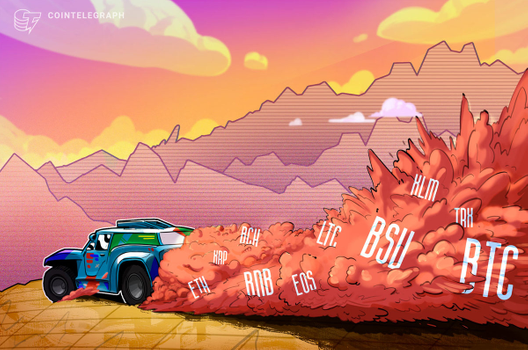Space is an area that has been historically researched by few governments, being a complex matter that requires thorough, high-class research and, therefore, substantial funding. More recently, with the emerging popularity of audacious startups like SpaceX, space exploration has become a less exclusive area. Now, however, it seems that the cryptocurrencies’ primary features — blockchain, its underlying technology, and the concept of an Initial Coin Offering (ICO), its crowdfunding model — are bringing in even more power into the previously unshared territory.
Big players are adopting blockchain for space exploration:
Space giants like the U.S. National Aeronautics and Space Administration (NASA) and the European Space Agency (ESA) are studying ways to employ blockchain for their mission. Findings obtained so far suggest that the technology might be useful both on the ground (facilitating data-related processes, just like in other mainstream institutions) and in space (helping to navigate the deep space).
NASA
In 2017, NASA awarded a $330,000 grant that supported the development of an autonomous, blockchain-based spacecraft system, making its first move toward blockchain adoption. Called the Resilient Networking and Computing Paradigm (RNCP), the new system relies on blockchain and requires no human intervention, as the grant’s recipient, Dr. Jin Wei Kocsis — an assistant professor of electrical and computer engineering at the University of Akron — outlines in her research synopsis.
As Kocsis explains, the RNCP will examine the application of Ethereum-based blockchain smart contracts in developing a secure computing system that would be applicable for challenging space conditions:
“In this project, the Ethereum blockchain technology will be exploited to develop a decentralized, secure, and cognitive networking and computing infrastructure for deep space exploration. The blockchain consensus protocols will be further explored to improve the resilience of the infrastructure[…] I hope to develop technology that can recognize environmental threats and avoid them, as well as complete a number of tasks automatically.”
In more detail, the RNCP system will exploit smart contracts to build a spacecraft that would automatically and promptly detect and dodge any hindrance — as in deep space, conventional means of communication become less reliable as the signal gets weaker. Thus, Dr. Kocsis hopes that, equipped with this blockchain solution, spacecraft will be able to complete more tasks, provide more data and give scientists more time for information analysis, as they would not have to spend time on detecting potential environmental threats. No specific timeline has been disclosed thus far.

ESA
The European Space Agency (ESA) — NASA’s counterpart in the EU — has been studying blockchain as well, although they are more likely to use the technology to streamline internal administrative processes, not launch it to the deep space per se.
In September 2017, ESA presented a report dubbed “Distributed Ledger Technology: Leveraging Blockchain for ESA’s Success.” The paper outlines general pros and cons of blockchain with some specific examples (i.e. “it saves Dubai 25.1 million hours of productivity”), and then focuses on the potential benefits suitable for ESA specifically — namely the use of smart contracts in logistics, swifter and precise payments, real-time access to data changes, seamless updates to access rights and an immutable voting system, among others.
Notably, the agency discusses the prospect of applying blockchain in the context of so-called Space 4.0, defined as “a situation in which there is the increased number of diverse space actors around the world.” One of the paper’s authors, ESA Senior Corporate Development Coordinator Gianluigi Baldesi, opined at a workshop held at the European Space Research and Technology Centre (ESRTC) in October 2017:
“In the era of Space 4.0 — as in our own lives — we have to be adaptive to change and nurture a culture of pro-activeness and open-mindedness to both disruption and opportunity,” said Baldesi.
Smaller startups step in as space becomes more democratized
Indeed, space is no longer exclusive to governments that have the means to constantly fuel their research programs with cash: With the arrival of low-cost satellites, blockchain can be launched into space, cutting ties with infrastructure that cannot be fully decentralized — as it’s still plugged in with Facebook and Google fiber optic cables. Here are some startups that are hoping to further democratize the cosmos, although it’s worth noting that most of them don’t feature any specific timelines and are thus rather immature:

Space Decentral
Space Decentral is a Singapore-based startup and a decentralized autonomous organization (DAO), as per its white paper released early in 2018. Essentially, it is based on the idea that, while space pioneers such as the U.S. and Russia are still important for space exploration, the cosmos is becoming more democratized, and now there are more opportunities available even for private players — essentially the same argument that backbones the concept of Space 4.0 mentioned above.
While the project’s plan is notably vague, essentially it promises “to enable hundreds of thousands of new actors to be a part of a global space agency not only as financial supporters, but also as integral contributors of knowledge, regardless of nationality,” by providing the means to crowdfund and crowdsource various space-related projects that could hardly be sponsored through older models — as an ICO makes the overall process easier. Space Decentral has voiced their plans to issue a utility token called the Faster Than Light Coin (FTL Coin).
The startup’s recently announced its “first decentralized space program” called Coral, which is lead by four former NASA employees. Its primary aim is to facilitate 3D printing on the lunar surface to build infrastructure for settlers.
SpaceChain
The startup SpaceChain is less about space exploration and more about using the existing infrastructure to improve the blockchain experience, although outer space is also involved in this case. Basically, SpaceChain is building the world’s first open-source satellite network that runs on blockchain nodes. Indeed, its CEO Zheng Zuo seems to know the price of true decentralization, based on a comment he provided for Tech in Asia:
“You can run a decentralized e-commerce platform, but in the backend, you’re using [Amazon Web Services]. It’s their technology infrastructure[…] After we all start depending on this centralized service, it’s hard to realize true decentralization.”
Backed by former Bitcoin developer and CEO of Bloq Jeff Garzik and one of the most prominent crypto investors Tim Draper, SpaceChain launched their first low-orbit satellite — based on the affordable CubeSat technology — in February 2018. This way, the startup hopes to establish a fully decentralized network that, backed by SpaceChain’s open-source operating system, aims to become a blockchain sandbox for other developers. As the SpaceChain team explains in their Medium post:
“The satellites are used as blockchain nodes for data processing, transmission, in-space data storage and application development. SpaceChain also integrates with Qtum to provide the basic service API for smart contracts and blockchain application.”

Blockstream
The idea of a decentralized, distant blockchain that is powered by satellites isn’t particularly new — a startup called Blockstream started to utilize the concept back in 2017, when it announced its Blockstream Satellite project, aiming to beam blockchain to every person on planet Earth and even performed its first transaction.
To run a space-based blockchain, Blockstream Satellite relied on open-source technologies: its press release cited GNU Radio and Fast Internet Bitcoin Relay Engine (FIBRE) as incorporated technologies, while the FAQ elaborates:
“Anyone can receive the signal with a small satellite dish (similar to a consumer satellite TV dish) and a USB SDR (software-defined radio) interface[…] The total equipment cost for a user is only about $100. The software is free. The software interface is the open-source GNU Radio software, which is the receiver. GNU Radio will send data to the FIBRE protocol, which is the Bitcoin process and is where the blocks reside.”
Africa, Europe, South America and North America were the first regions where users could download a beta node — essentially, two thirds of the planet had been covered. According to the network status, other regions haven’t been introduced yet.
Nexus
Nexus is an Arizona-based startup that has announced the so-called “world’s first three dimensional blockchain.” Notably, the concept involves a satellite network that Nexus is developing in partnership with Vector Space Systems. Its mission is to “provide global access to its digital currency and autonomous internet infrastructure using Vector’s Galactic Sky software-defined platform in a Low Earth Orbit (LEO) satellite network,” which is rather similar to the above mentioned projects.
Nexus additionally stresses the importance of decentralization in a world dominated by giant corporations:
“A space-based platform offers greater redundancy and security for decentralized applications, since satellites are resistant to regulation or control by government and corporate entities.”
Moreover, the startup hopes to provide “reliable and affordable” internet access via its satellite-powered blockchain network, while the revenue collected from the featured commercial applications will be used to pay for the maintenance and operation of the network, lowering costs for casual customers.









